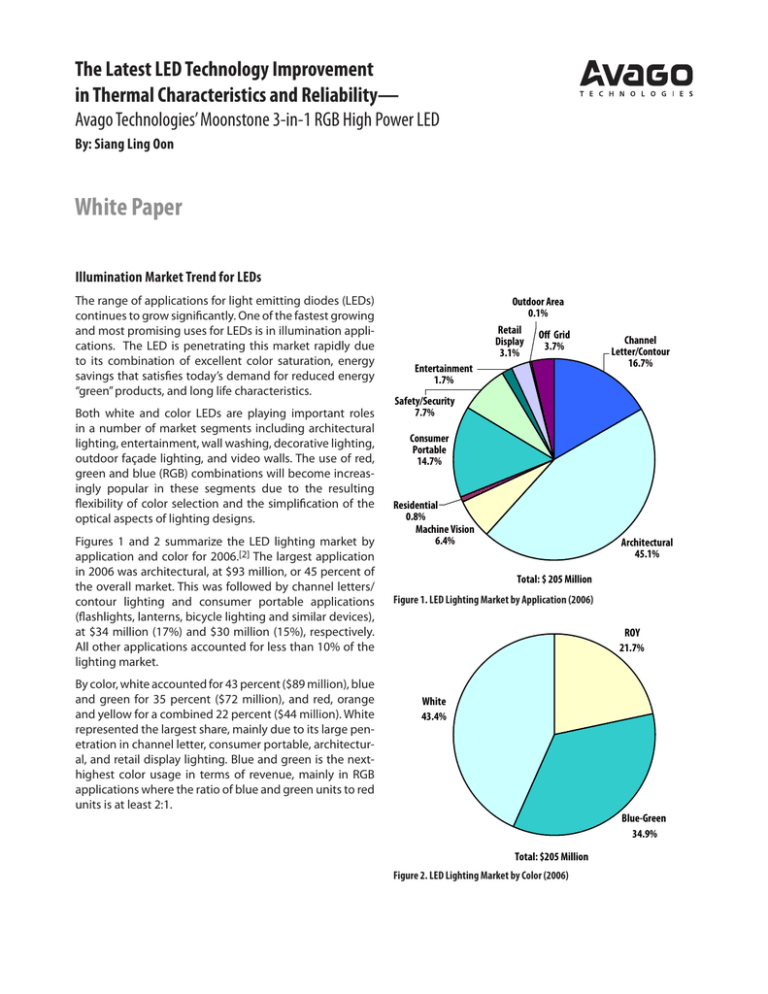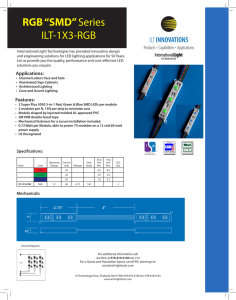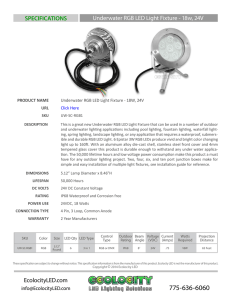
The Latest LED Technology Improvement
in Thermal Characteristics and Reliability—
Avago Technologies’ Moonstone 3-in-1 RGB High Power LED
By: Siang Ling Oon
White Paper
Illumination Market Trend for LEDs
The range of applications for light emitting diodes (LEDs)
continues to grow significantly. One of the fastest growing
and most promising uses for LEDs is in illumination applications. The LED is penetrating this market rapidly due
to its combination of excellent color saturation, energy
savings that satisfies today’s demand for reduced energy
“green” products, and long life characteristics.
Both white and color LEDs are playing important roles
in a number of market segments including architectural
lighting, entertainment, wall washing, decorative lighting,
outdoor façade lighting, and video walls. The use of red,
green and blue (RGB) combinations will become increasingly popular in these segments due to the resulting
flexibility of color selection and the simplification of the
optical aspects of lighting designs.
Figures 1 and 2 summarize the LED lighting market by
application and color for 2006.[2] The largest application
in 2006 was architectural, at $93 million, or 45 percent of
the overall market. This was followed by channel letters/
contour lighting and consumer portable applications
(flashlights, lanterns, bicycle lighting and similar devices),
at $34 million (17%) and $30 million (15%), respectively.
All other applications accounted for less than 10% of the
lighting market.
By color, white accounted for 43 percent ($89 million), blue
and green for 35 percent ($72 million), and red, orange
and yellow for a combined 22 percent ($44 million). White
represented the largest share, mainly due to its large penetration in channel letter, consumer portable, architectural, and retail display lighting. Blue and green is the nexthighest color usage in terms of revenue, mainly in RGB
applications where the ratio of blue and green units to red
units is at least 2:1.
Outdoor Area
0.1%
Retail
Display
3.1%
Off Grid
3.7%
Entertainment
1.7%
Channel
Letter/Contour
16.7%
Safety/Security
7.7%
Consumer
Portable
14.7%
Residential
0.8%
Machine Vision
6.4%
Architectural
45.1%
Total: $ 205 Million
Figure 1. LED Lighting Market by Application (2006)
ROY
21.7%
White
43.4%
Blue-Green
34.9%
Total: $205 Million
Figure 2. LED Lighting Market by Color (2006)
One of Avago Technologies' innovative approaches to the
lighting market was the development of the Moonstone®
LED package.
Avago Technologies' Moonstone LED emitters are available
in one of the industry’s thinnest packages (15.85 mm x 8.5
mm x 3.3 mm), and are encapsulated in a heat- and UV-resistant silicone compound for high reliability and long life.
The competitively priced Moonstone LED emitters provide
designers of solid-state lighting with many features, such
as a wide viewing angle radiation pattern, superior heat
dissipation, and thin packaging. All this makes them ideal
for use where height is a constraint. Typical applications
include architectural façade lighting, track lights, spot
lights, and decorative lighting applications.
With an exposed pad design on the back of the package,
the Moonstone emitter package has low thermal resistance and is able to efficiently transfer heat from the
package to the motherboard to maintain long term reliability. These emitters are compatible with standard SMT
reflow soldering processes to provide lighting designers
with more freedom and flexibility in designing their applications. In addition, the package is qualified to a JEDEC
moisture sensitivity level (MSL) rating of 2A. (For manufacturers, this rating means that the devices can be kept
in the open air (30°C, 60 percent relative humidity) for
up to four weeks after being removed from their sealed
package without the need to remove absorbed moisture).
The Moonstone LEDs are specified for operation in the
–40°C to +95°C temperature range, and are capable of
withstanding electrostatic discharge (ESD) levels of 16
kV (class 3b) per ESD Association standard ESD STM5.1,
Electrostatic Discharge Sensitivity Testing—Human Body
Model.
Moonstone 3 W LED emitters in warm white and cool
white are capable of being driven to 700 mA, providing a
light output of up to 161 lumens, and are available with a
110° or 120° viewing angle.
The newest version is the 3-in-1 Moonstone emitter,
combining red, green and blue LED chips into a single
package (Figs 3 and 4). Each color can be driven at up to
350 mA, for a typical flux output of 108 lm (40 lm red, 55 lm
green, and 13 lm blue). Color mixing provides hundreds
of thousands of colors, making the 3-in-1 emitter ideal
for applications including instrumentation, interior or
exterior illumination, mood lighting, and special effects.
Figure 3. The 3-in-1 RGB Moonstone LED package (ASMT-MT00)
3.30
R+
10.00
Metal Slug
( Heat Sink)
10.50
Moonstone 0.5 W LED emitters are supplied in warm
white (2600 K to 4000 K) and cool white (4000 K to 10,000
K color temperature), with a choice of non-diffused or
diffused packages and an option of electrically-isolated or
non-isolated slugs. They provide 30 lumens (lm) (typical)
and up to 43 lm cool white light output at 150 mA drive
current, with a 110° viewing angle.
Moonstone 1 W LED emitters are supplied in warm white
and cool white, with a drive current rating of 350 mA and
a choice of a 110° or 120° viewing angle. The cool white
versions provide up to 80 lm output.
They are also available in AlInGaP:
• amber (582–595 nm wavelength/ 35 lm typ. luminous
flux)
• red (620–635 nm/ 40 lm typ.),
InGaN:
• green (515–535 nm/ 40 lm typ.)
• blue (460–480 nm, 10 lm typ.).
2
1.27
8.50
5.25
G+ G
1.27
R
R+ B B+
0.64
Figure 4. Outline drawing of the 3-in-1 RGB Moonstone LED package
(ASMT-MT00), showing dimensions.
Benefits of Integrated 3-in-1 RGB LED Packaging
The conventional approach to assembling RGB LEDs
for illumination applications is to use separate, discrete
packages for each color, arranging the packages on a
printed circuit board to achieve an RGB light source. In applications such as architectural, entertainment, outdoor
facade and decorative lighting, this will be more challenging for secondary optic designs, including a collimated lens for RGB that is used to illuminate an area some
distance away. The lens and printed circuit board sizes will
have to be enlarged once the pitch size between the LEDs
increases. At the same time, the cost of a secondary optic
design and materials will also increase.
In contrast, the 3-in-1 approach directly mounts the RGB
LED die into the same package. Each die can be individually addressed, which means that each has its own electrical
channel to provide a range of colors. This enables the light
source to be compact, compared with separately packaged
devices, and the pitch between individual light sources to
be significantly reduced, which is important in achieving
the best color quality. The minimum pitch required for
LED light sources to achieve good color mixing is approximately 5 mm. The 3-in-1 approach reduces the pitch to as
little as 1.5 mm [Figure 5]. Once the pitch is reduced, the
area required for effective color mixing also is reduced. The
effect of RGB stray light also will be minimized when approaching white color [Figure 6].
Encapsulation
Substrate
Encapsulation
Reflector
Discrete LED
1.5mm pitch
LED Chip
3-in-1 Solution: reduced chip to chip pitch
A copper lead frame (substrate) enables the lowest thermal
resistance. The heat generated by the operating LED chips
can be efficiently transferred to the heat sink through
the frame; copper’s thermal conductivity is superior to
ceramic, mild steel and aluminum [Figure 7].
LED Junction
Substrate
Thermal Path
LED Junction to Chip
Chip to DA Adhesive
Solder
Paste
DA Adhesive to substrate
Substrate to Solder
MCPCB
Solder to MCPCB
Figure 7. 3-in-1 RGB package thermal path
Good Thermal and Reliability Performance
LED Chip
5mm pitch
In the Avago Technologies' 3-in-1 package, high performance polyphthalamide plastic is used as both the
package housing and the reflector. This material can
operate under conditions of high-temperature, high-UV
light levels for long periods while maintaining surface
reflectivity. If the wrong material is chosen as a reflector,
however, the light output performance can drop significantly because of its white surface, which becomes yellow
or brown over time after experiencing high temperatures.
PCB
Reflector
The thermal resistance has been verified using the
FLOTHERM computational fluid dynamics (CFD) program
from FLOMERICS Group PLC. In the simulation model, the
reflector, lead frame, encapsulation, die attach layer and
dice are created. A 1W power source is created on top of
each die. The simulation visualization result can be seen
in Figure 8.
Metal Substrate
Figure 5. Pitch size comparison between discrete component solution and
3-in-1 solution
More
Area
Discrete Component Approach
Less
Area
3-in-1 package Approach
Figure 6. 3-in-1 package approach reduces the required color mixing area
3
Figure 8. Simulation visualization results for 3-in-1 RGB LED package
The simulated thermal resistance from junction to pin
(Rjp) for the red, green, and blue die are 23°C/W, 20°C/W,
and 20°C/W, respectively. These thermal resistance values
have also been verified by actual measurement using the
forward voltage method. The results of actual measurements are very close to the simulation.
Furthermore, the package thermal performance has also
been validated through operating life tests of up to 5000
hours.
Reliability testing was performed in a temperature
chamber and showed low degradation after 5000 hours
at +100°C operation [Figure 9]. The InGaN die show an approximate 12 to 18 percent Iv drop and the AllnGaP die, an
10 percent Iv drop.
15
Red
Delta Iv-Average (%)
10
Blue
Green
0
1000
2000
3000
4000
5000
-5
Avago Technologies offers extensive technology and
products in the LED illumination field, providing mid- and
high-power LED devices ranging from mid-power PLCC
surface-mount emitters in both warm and cool white
and a range of colors, to the Moonstone emitters, Star-1
and Star-2 PC assemblies, 3.5 and 5-watt multi-chip white
LED modules and 24-watt multi-chip LED modules. For
detailed information on these or other Avago Technologies' lighting products, go to http://www.avagotechlighting.com/.
The author would like to thank Mok Thye Linn and Chia
Chee Wai for their valuable information and support.
References
[1] T. L. Mok, “Ultra Thin Profile RGB LED Module for LCD
Monitors and TV Backlighting,” International Display
Workshop, Otsu, 2006
-10
-15
-20
The 3-in-1 package solution provides better performance
than conventional discrete LED packages in terms of characteristics such as color mixing and space requirements,
while featuring good thermal performance and reliability characteristics. It also provides greater flexibility for
system designers in developing their applications.
Acknowledgement
5
0
Conclusion
Test point (hrs)
Figure 9. Degradation of LEDs during high temperature operation
For product information and a complete list of distributors, please go to our web site:
[2] Strategies Unlimited, HB LED Market Review and
Forecast 2007 (illumination market forecast)
www.avagotech.com
Avago, Avago Technologies, and the A logo are trademarks of Avago Technologies in the United States and other countries.
Data subject to change. Copyright © 2005-2010 Avago Technologies. All rights reserved.
AV02-1752EN - March 17, 2010




